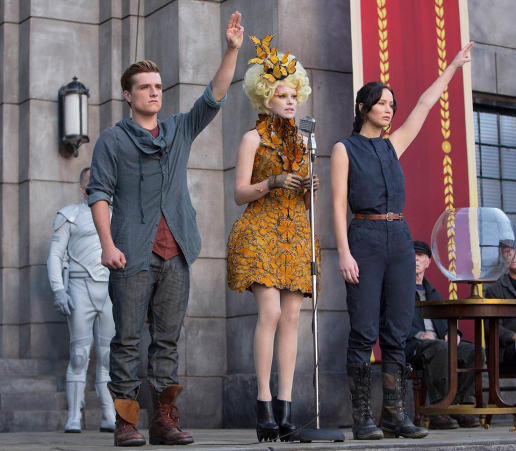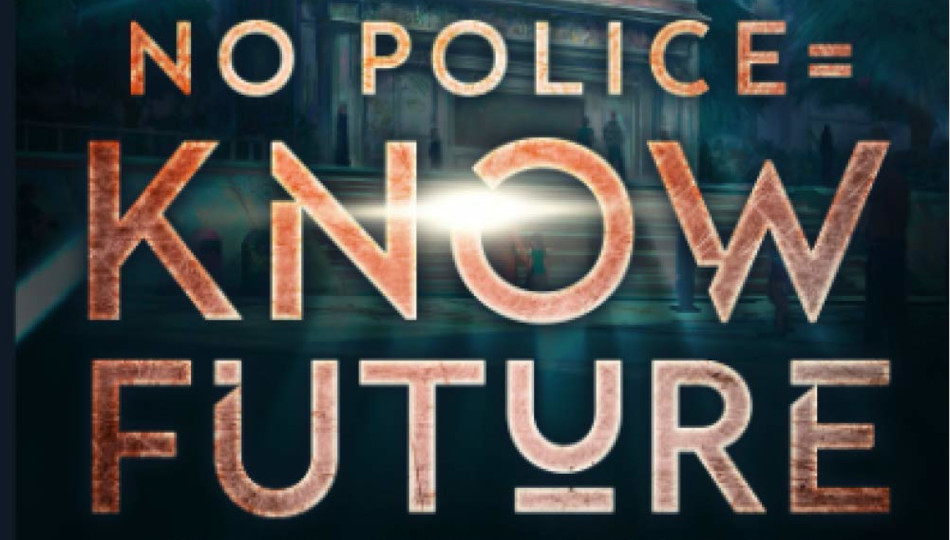Hi again! The column that was published last week was supposed to be this one; a mistake was made, so instead of Part 2 of the Winston saga, this week you’re getting a review. Hope that’s okay, because it’s too late to change it. Stuff happens, right? So on to the review.
Disclosure: I was not a big fan of the book franchise Hunger Games by Suzanne Collins. I believe our local Coles (in the big mall, Metrotown) brought her in when the last book (Mockingjay) came out for an autograph session, similar to what they did with Stephenie Meyer for whichever Twilight book came out a couple of years ago; I didn’t go. At the time I’d read none of the books because, frankly, there are just too many books to read everything. And as my wife, the Beautiful and Talented Lynne Taylor Fahnestalk (www.smilingdragonflystudio.com) says, it’s a YA book by a YA author, which means it’s somewhat simplified for its target audience. (Simple conflict, simple romantic triangle, etc.) That didn’t bother me so much upon reading the series.

What bothered me most was the whole setup—the entire premise—of the series. We’re told, in Hunger Games, the first book, that North America (I can’t tell whether she’s saying just the US or the US and Canada) suffered droughts, fires, floods, unspecified disasters and rising sea levels; after it stabilized and “Panem” was created with 13 districts, the districts rebelled against the Capitol district, which somehow overcame all the other districts and then obliterated the 13th district as a punishment and object lesson to the remaining 12. And created the Hunger Games also as punishment and reminder. Y’see, I like my science fiction to have a bit of a reality grounding, and none of that rings true to me. Literally none. I won’t go into it further, because I’m sure you can all do the math yourselves, but ask yourselves: would Canadians or Americans stand for the Hunger Games, and even if so, how would “The Capitol District” alone overcome the rest of the continent? I cry “bushwa!”
Okay, that being said, it’s written for a YA audience: today’s YAs are not given to the wholesale learning of facts that my generation was; I believe the emphasis is more on process and critical thinking rather than rote memorization. So to an audience without a good historical grounding, maybe it would fly. I’ve read the whole series, and watched the first two movies as they came out; I like to keep au courant of what’s happening in popular culture to a degree. (But only to a degree: you won’t catch me watching The Bachelor or any one of a dozen low-brow shows—Kardashians, anyone?—that to me appear to be “bread and circuses” designed to occupy the ever-narrowing minds of the hoi polloi. And when I say that, I mean that it’s becoming increasingly obvious that we’re approaching the kind of TV pictured in Robocop or Kornbluth’s The Marching Morons. Whether it’s “I’d buy that for a dollar” or “Would you buy that for a quarter?” there’s a level of “entertainment” in movies and television which I and a bunch of others—I hope you’re one of them, too—don’t find particularly entertaining.)
The first movie was, in my opinion, just okay. It adhered pretty well to the book and, like the second one—this one, Catching Fire—in the series, most of what’s in the movie is in the book, even if some of the stuff in the book is not in the movie. As a good movie adaptation should, they left out or glossed over some non-critical elements. And before I proceed, I hope you who are reading this has either seen the first movie or read the first book; I shouldn’t spend half this column telling you things you should already know. Very briefly, though—North America is now home only to a country called “Panem,” which is divided into The Capitol and twelve numbered districts. (There used to be thirteen, but the Districts revolted against the Capitol and lost. In retaliation, the Capitol bombed District 13 out of existence and instituted the Hunger Games, wherein each District has to send two Tributes, a male and a female between the ages of 13 and 18—a process called The Reaping—annually to an arena where they will do their best to kill each other until only one is left.)

In the first book/movie, our heroine Katniss Everdeen volunteered to become a Tribute—to spare her younger sister Primrose, whose name was actually drawn, from becoming Tribute—in the 74th annual Hunger Games, and through a suicide threat she and her fellow Tribute (Peeta Mellark) from District 12 (the only two survivors) became the first-ever twin Tributes to survive. But the Capitol’s reign over the Districts is onerous; there are electrified fences around each District and armed and armoured blank-visored “Peacekeepers” in white to hold the Districts in subjugation. District 12, Katniss’s home, is a coal-mining District, similar to Pennsylvania or Kentucky in the 1920s, and there is seldom enough to eat and electricity only three hours a day at the most. Meanwhile, in the Capitol, they have all kinds of modern technology and fancy clothes and buildings and more than enough to eat—enough that, like the Romans with their Vomitoriums, they eat until they’re full, throw up, and eat some more.
Although Katniss and Peeta’s “suicide pact” was a move of desperation, President Snow (Donald Sutherland) saw in it a rebellious move and the seeds of revolution. And when his own granddaughter—“everyone in my school’s doing it, Grandpa”—starts wearing her hair in Katniss’s signature single braid; well, the poop hits the propellor. Calling the new Games Master (the old one suffered a fatality after K&P broke all the rules), Plutarch Heavensbee (Philip Seymour Hoffman) to his side, Snow decrees that all “her species” (i.e., the survivors of the Hunger Games)—especially you-know-who—have to die! (The usual routine for the H.G. is that the winner becomes a “mentor” for any Tributes in his or her District and gets to move into a new house in the Winners’ Village and becomes rich for the rest of his or her natural life. The only mentor left in District 12 is Haymitch Abernathy (Woody Harrelson), who decided that the rest of his life was best spent in a drunken stupor, reviving only to coach Katniss and Peeta (played pretty much as a mooncalf by Josh Hutcherson; Peeta was the baker’s son, and gave Katniss free bread and buns because he was in love with her. Too bad for him: she was in love with Gale Hawthorne. Hawthorne’s played by Liam Hemsworth, and he has little enough to do in this movie besides looking remarkably clean for someone who spends his days underground mining coal.)

Snow visits Katniss at her home, and tells her she must convince him—and thereby the rest of Panem—that she really is in love with Peeta. On their victory tour of the Districts, Snow gives her a little shake of the head to tell her she failed to do so. By the way, Elizabeth Banks gives a terrific performance as Effie Trinket, the strangely dolled-up escort for the District 12 winners. It’s not a big role, but as they say, there are no small roles–only small players. So, since this is the 75th H.G. coming up, and that’s the third Quarter Quell—there’s a Quarter Quell every 25 years—Snow changes the rules and announces that this Quarter Quell’s Tributes will be drawn from all the previous winners regardless of age or infirmity.
About the first half of this movie is taken up with all this drama. Katniss wonders if she and Gale should run away—she can sneak under the electrified fence in a segment that’s not terribly electrified, and has been hunting wild game in The Woods with her bow for years despite the rules which say she could be flogged or killed for it—and, if she does leave, will Snow kill her family? (He says he will do so unless she convinces him that she’s really in love with Peeta. He knows she’s not; he knows about Gale and the sneaking out—the whole district has hidden cameras all over it, apparently, which comes as no surprise to the viewer.) In an effort to convince everyone, Peeta proposes marriage to Katniss in front of Stanley Tucci’s manic Master of Ceremonies Caesar Flickerman and the whole of Panem via TV at the end of the Victory Tour—before the Quarter Quell is announced. Meanwhile, Snow has replaced their District’s head Peacekeeper with a real vicious guy—not that they’re all not vicious, but they’ve grown used to theirs in District 12, and he to them, even buying illicit goods at the illegal flea market—who immediately electrifies the whole fence, closes down the illegal flea market (the Hob), burning it to the ground, and begins a process of flogging and pacification. Of course, the first person flogged is not Peeta, or Katniss, but Gale. This leads to an on-camera confrontation when Katniss interposes herself between Gale and the new Peacekeeper Commander for District 12, Romulus Thread, escalating when Thread offers to kill Katniss, Gale, Peeta and Haymitch. Haymitch convinces Thread that this wouldn’t be a wise career move (“true dat”; the whole thing is being watched by Snow and Heavensbee).

I should say here, speaking of the Victory Tour, that in concert with other emcees like Joel Grey’s Master of Ceremonies in Cabaret, Richard Dawson’s Damon Killian in The Running Man and Chris Tucker’s Ruby Rhod in The Fifth Element, Caesar Flickerman is a character you can’t take your eyes off, in a role it’s impossible to overplay. From his outrageous hairdo (blue in this movie) to his large fake white teeth and his shiny/glittery suits, Tucci is perfect. But again, I digress.
Finally we get to the actual Quarter Quell. Katniss knows that Snow wants her dead; because her Mockingjay pin has become an inspiration and a symbol for the nascent rebellion (as her hairdo has, and the three-fingered District 12 salute and the mockingjay’s four-note song)—and on the Victory Train she accidentally learned that other Districts are beginning to rebel—and she doesn’t want reprisals to her, Peeta’s or Gale’s families. She gets Haymitch to promise that if Peeta’s name is drawn he will volunteer to take Peeta’s place; she figures that Haymitch has a better chance to survive. At this point, she thinks her death will save her family—she knows that two winners won’t ever happen again—from President Snow. The surprise comes when Haymitch’s name is drawn as the male Tribute and Peeta volunteers to take his place. At this point, though, there is nothing she can do about it. Haymitch goes about coaching Katniss and Peeta in how to make allies for the early part of the Game, when those without allies are most likely to die right off the bat. Among the unlikely allies she makes are Beetee (Jeffrey Wright, who played Felix Leiter in Casino Royale) and Wiress (Amanda Plummer, who you probably remember best as “Honeybunny” in Pulp Fiction), a pair of techie types who are unlikely to survive on their own, and Finnick (Sam Claflin) a real hotshot type.
The new Arena has a surprise or two in store for the Tributes—the Cornucopia, where the Tributes first pick up their weapons and supplies—is in the middle of what appears to be a man-made lake; the tributes are on stands in the middle of each of twelve segments (one for each District), and they must immediately dive into the water and get to one of the rocky segment dividers in order to get to the weapons and supplies. Several Tributes die in this process; Katniss and her allies manage to make it to the treeline. And as much as I’d love to continue discussing the storyline here, I must quit for fear of giving too much away. You know I hate spoilers (not so much for myself—I can watch a movie for the first time while already knowing everything about it; I can still enjoy it. But for those of you like my wife, who hates knowing anything in advance and refuses to watch trailers that give too much away), so I will break off here.

I liked this movie much more than I did The Hunger Games, the first one. Why is this better than the first installment? For me, first, it was easy to forget the unbelievable parts of the storyline, and just “go with the flow.” I treated this film like a ding an sich; took it for itself and didn’t worry about the setup. Without that worry—and wondering how the Capitol managed to get all this high technology (technology somewhat in advance of ours!) while keeping all the districts in poverty, for example—I was able to enjoy the special effects and the performances. And the performances are, for the most part, pretty good. Jennifer Lawrence is excellent; her character displays a full range of emotions without it being obvious she’s acting. Her performance is natural. Sutherland’s President Snow is suitably nasty—but it’s a role he can probably play in his sleep, even though it’s hard to underplay that kind of role. Hoffman is—and this may be the last time we see him unless he has something else already in the can—as usual, competent. Woody Harrelson is okay, but like Liam Hemsworth isn’t called on for a full range of emoting or emotion. I can’t say much more without spoilers. Even Lenny Kravitz as Katniss’s dresser, Cinna, is good in his minor role.
The sets are extremely well done; the Capitol sets bring a Leni Riefenstahl grandeur to the Victory Tour, as probably was intended. (For those of you unfamiliar with Riefenstahl, I believe her 1935 Nazi propaganda film Triumph des Willens—The Triumph of the Will—is available through YouTube. I am NOT promoting the cause of the German National Socialist Party, the Nazis, in any way. I merely mention Riefenstahl because that film became the “poster child” of propaganda movies.) The special effects serve the story without overwhelming it. Sometimes it’s nearly impossible to tell what’s a CG effect and what’s a practical (i.e., mechanical or “real” vs. computer) effect. Again, because of spoilers I can’t mention too many of the effects as a majority of them fall in the actual game; although the “catching fire” clothing illusion Katniss and Peeta wore during the Victory Tour finale, as well as the “wedding dress” scene with Caesar Flickerman were very good. All in all, the movie works; leaving you wanting more… and eager for the last installment. Can’t say better or fairer than that, can you?
By the way, if you’re looking for humour, please DON’T watch the movie Hungry Games, which purports to be a takeoff on either this movie or the first one. Although the young woman who plays “Cantmiss Evershot” is attractive and manages to keep her composure throughout the approximately half-hour I watched, the movie was apparently (I found it on Netflix) made with a budget of approximately $150, or maybe, to be kind, $200. The sets and effects, not to mention the writing, are abysmal. I didn’t finish it, because the jokes were flat, obvious, and depended on bathroom humour and crotch jokes for a large part. I wish I could get my half-hour back. Sigh.
If you’d like to comment on this week’s entry, you can either register here, if you haven’t already—it’s free, and only takes a moment—or comment on my Facebook page; or in the several groups where I publish a link. All your comments—positive or not—are welcome! Feel free to disagree; my opinion is, as always, my own, and doesn’t necessarily reflect the views of Amazing Stories or its owners. See you next week!










